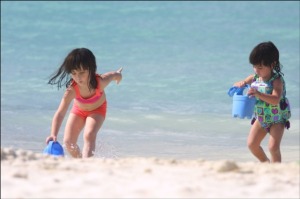Shore Vacations Increase Risk of Skin Cancer in Kids
by
Joan Trombetti, Writer | June 03, 2009

Risky Play
A study funded by the National Cancer Institute suggests that taking the kids on shore vacations is associated with increased numbers of nevi, which may increase their risk of developing skin cancer some day, researchers here said. Although moles are not dangerous in themselves, they do serve as markers for past sun exposure. The study also suggested that each trip to a shore before the age of seven was associated with a 5% increase in small nevi(mole) (95% CI 1% to 9%) after controlling for sunburns, said Lori Crane, Ph.D., of the University of Colorado, and colleagues from the examinations of 682 white children and interviews with their parents. The nevi markers of past sun exposure are an indirect measure of future skin cancer risk.
In the February issue of Cancer Epidemiology, Biomarkers and Prevention, Dr. Crane and colleagues wrote that "Parents should be aware of the effect that vacations may have on their children's risk for developing melanoma as adults and they should be cautious about selection of vacation locations." They also pointed out that parental education and income were associated with more frequent waterside vacations, suggesting that higher socioeconomic status may increase children's future skin cancer risk. The study did not address development of skin cancers and was conducted in children born in 1998 and who lived continuously in Colorado, where there are approximately 300 sunny days per year, so the children's sun exposure was relatively high to begin with.
Children in the study underwent exams at age seven, during 2005, yielding counts of nevi less than 2 mm in diameter and larger nevi.
Parents were interviewed each year from 2003 to 2005 to gather data on vacations, sun exposure, and sun protection.
Vacations were classified either as waterside or not, depending on whether it was likely that children would be outside in swimwear for long periods.
Thus, any trip to a location featuring a body of water known for recreational activities ordinarily associated with such activities as surfing, water skiing, and boating, but excluding fishing, was counted as waterside.
The researchers also took the time of year for vacations and the destination's general climate into account in determining whether a trip involved significant sun exposure.
On that basis, trips to Hawaii were considered waterside at any time of year; vacations to coastal North Carolina were waterside only in the summer; and visits to San Francisco were never waterside because vacationers there rarely engage in swim-related activities.
